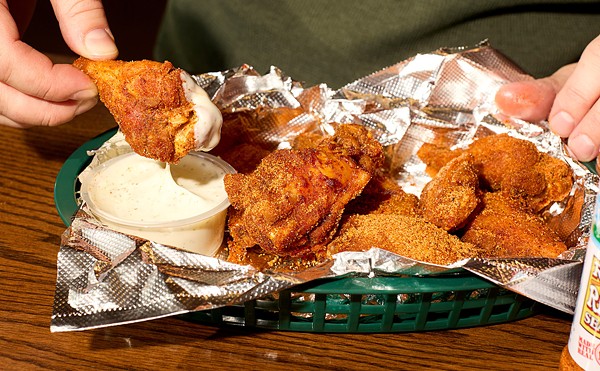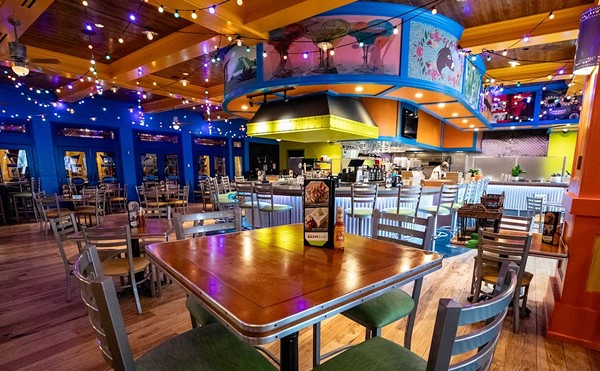Is there a better place to be hungry in St. Louis than South Grand Boulevard? Only if you are terminally indecisive. In the six blocks between Arsenal Street and Utah Place, you can feast on pho, sea urchin, beef tongue, fresh pasta and gelato. Feeling adventurous? Try kitfo, a fiery dish of minced raw beef at Meskerem Ethiopian Restaurant — or just venture inside City Diner after the 3 a.m. bars close.
The latest entry into this polyglot mix is the Vine Mediterranean Cafe & Market, which opened last November next-door to Wei Hong Bakery & Restaurant and across the street from the wondrous Jay International grocery store. The Vine occupies two contiguous storefronts, the northern half a small market, the southern half the restaurant proper. The dining space is bright and attractive, its color scheme a faint, aqueous green, its décor featuring such playful touches as wooden cutouts of palm trees and grape bunches, the latter concealing the stereo speakers.
At the back of the restaurant is a display case for baked goods, as well as the fruits and vegetables for the selection of juices. (The lemonade is perfectly quenching.) The Vine does not serve alcohol, but for those who need a vice with their meal, a hookah bar sits perpendicular to the display case, its array of ornate water pipes likely to impress even a militant nonsmoker.
A pass-through affords a glimpse into the kitchen: At certain angles you can see the vertical spits on which spin inverted cones of meat and chicken shawarma. The meat shawarma is an especially beguiling sight, a patchwork of beef and lamb as thick as a linebacker's thigh. This is sliced to order and served over rice with pita bread and a tangy tahini sauce — a build-your-own-gyro kit, if you like.
Folded into a pita or eaten plain with your fork, the Vine's meat shawarma is nothing short of excellent. Inevitably your order will contain a few pieces from the exterior of the spit — crisp, even crunchy, and enjoyable in its own way, like the edges of pork carnitas. But the majority of the meat is so tender you might think it had been braised. Really, the process isn't very different, as the spit's long, slow spinning gives the fat inside the meat time to render. The flavor has the richness of pot roast, with enough of lamb's gaminess to keep things lively on the palate.
If the chicken shawarma can't match the meat rendition's depth of flavor, it remains a tasty dish in its own right, reasonably tender — boneless chicken just doesn't take to spit-roasting as well as beef or lamb — and given a kick of savory spice. I tried it in sandwich form (a steal at $3.99), in which the chicken's flavor is further boosted by a strong garlic sauce and thin pickle wedges. (Get used to those pickles: They appear on practically every plate.)
Because the $3.99 brings only the sandwich, I paired it with an order of the homemade "Mediterranean-style" fries, the spuds sliced medium-thick and sprinkled with dill. Though an attractive golden brown, these were limp; they likely had been fried once rather than soaked in water, blanched and then quickly refried before being served.
Chicken kebabs can be tricky, too. Unlike beef, chicken has to be cooked through, which can lead to too much charring. The kitchen nails it, though, giving each sizable hunk of chicken a lightly sweet, mahogany exterior and a tender interior. The flavor is spiked with lemon, which pairs beautifully with a side of the same garlic sauce served with the sandwich.
Kebabs are also available in the form of rib-eye steak, lamb, shrimp and the seasoned ground-beef patty known as kafta. This last has a texture more like sausage than a hamburger and is very good, brightly spiced. The most extravagant meat entrée might be the grilled lamb chops: Each chop is enormous and includes the strip of fat (and just a little meat) that's usually trimmed to make the chops resemble chopsicles. The lamb itself tasted very good, with a strong char, but the accompanying sauce was fantastic: a tart blend of lemon, olive oil and spices that contrasted the meat's browned sweetness and highlighted the lamb's unique gaminess.
Turns out this is fattoush sauce — so called because it dresses the traditional salad of the same name, a mix of greens, cucumber, tomato and pieces of fried pita. The tart sauce gives fattoush more character than most salads; it is both an excellent palate cleanser and appetite whetter.
Vegetarians and vegans alike will be pleased to note that vegetarian dishes are denoted by a green leaf, vegan dishes by that same leaf with the letter V inside it. (Most of the vegetarian dishes are also vegan, it appears.) These include batata harra (spicy potatoes with cilantro), as well as grape leaves stuffed with vegetables and rice. Of course there is falafel, available on its own, in sandwich form or as a dinner entrée in all-you-can-eat "buffet" form. The Vine's falafel is among this town's better versions, with a satisfying crunch as the outer shell yields to the moist, garlicky chickpea mixture inside. Hummus, another reliable dish, is also a standout. The Vine serves it with a generous pool of olive oil on top, which adds an unctuous character to the already smooth dip.
On a couple of visits to the Vine, I encountered dishes listed on the menu that were not available. In this case, the disorganization was more than understandable: When I spoke with manager Ali Moshen on the phone, he said that his mother had passed away recently after an extended stay in the hospital, during which time the operation of the family-run restaurant had been hectic.
Truly, aside from those missing dishes, if the restaurant's operations suffered during this unfortunate time, I didn't notice it. And if there is a neighborhood that can shepherd a new eating establishment through such a trying time, it is this vibrant, welcoming stretch of South Grand.





